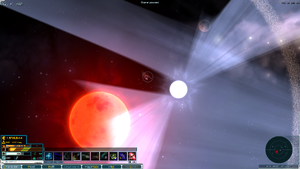Terrain
There are various terrain types in both the strategic level and also the combat level
Strategic map terrain
Strategic terrain can also impact sensors which is covered on the Sensors page
Asteroid Belt
x0.25 sensor profile when moving slowly, chance of impacting on an asteroid when not moving slowly, either slamming against the fleet's drive field or a ship, causing notable damage
Ring System
x0.25 sensor profile when moving slowly
Accretion Disk
x0.25 sensor profile when moving slowly, basically a ring for a black hole (be aware that getting to close to the black hole (usually just past the disk) can and will drag your fleet in, bring your CR crashing down to zero, and kill you)
Nebula
Slows down fleets based on size
Magnetic Field
x0.25 sensor profile
Magnetic Storm
Sensor profile locked to zero, but x0.25 sensor range
Deep Hyperspace
Same function as nebula, slows down fleets based on size
Hyperspace Storm
When not moving slowly, fleet will be struck by a "storm strike" that aggressively flings the fleet and sets a ship's CR to zero
Pulsar Beam / Neutron Star
| A relativistic, magnetized jet combined with intense radiation. Commonly emitted by neutron stars.
|
Reduces the combat readiness of all ships caught in the pulsar beam at a rapid pace, and blows the fleet off-course. The magnitude of the effect drops off rapidly with distance from the source.
Fortunately Pulsar Beams can be blocked by other celestial objects, even other Neutron Stars. Be aware that while you cannot always Emergency Burn out of a Pulsar Beam, as with all other terrain, you can Emergency Burn across a Neutron Star, as the Pulsar Beam only extends from it's edge.
Combat map terrain
Asteroids
Asteroids are individual, destructible objects on the battlefields that can block most weapons fire and most movement (excepting fighters and phased ships)
Nebula
Nebula incur a malus of -30%/-20%/-10%/0% speed. This is calculated after any zero flux speed boost is applied. Do note that level 1 of the Navigation skill to reduce terrain penalties does not apply to combat map nebula
Change History
0.9
- Hyperspace storms:
- Fixed tooltip
- Removed sensor profile penalty and speed penalty
- Changed CR drain effect to powerful "storm strikes" hitting random ships
- A strike reduces CR and deals armor/hull damage, but can't destroy a ship
- Larger fleets attract more powerful strikes
- Some strikes will not deal any damage - at most 1 every 5 seconds (on average) will
- Each strike gives the fleet a speed boost in a direction determined by the fleet's position relative to the storm cell and its speed
- Speed beyond burn level 20 does not cost extra fuel
- While speed-boosted, the fleet may briefly lose steering control
- Emergency Burn allows control while boosted
- Strikes are synced up with the "cloud lightning" visual/audio effects
- Entering an active hyper cell will cause a flurry of storm strikes - i.e, the timing is predictable
- Overall:
- Potential for more severe damage to individual ships
- Much less expensive in total, and lower per-day costs since not all ships are affected
- Situationally useful for faster travel
- Deep hyperspace:
- Now slows down larger fleets more than small ones
- Nebula:
- Now slows down larger fleets more than small ones
- Removed in-combat effect on ship speed
- Asteroid belts/fields:
- Do not slow down fleets directly
- Chance of "asteroid impacts" on the drive field, briefly knocking the fleet off course
- Heavier impacts on larger fleets
- Navigation skill helps mitigate impacts
- Magnetic field:
- Now reduces the range at which a fleet within can be detected by 75%
- When in magnetic storm, range is reduced by 100%, and the sensors of the fleet have their range reduced by 90%
- Goal: useful for sneaking around and hiding in
- In general: terrain that slows down fleets is where smaller fleets can run to get away from larger fleets

